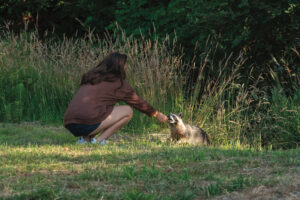Three summers ago, in late June, I took a hike at Purissima Redwoods on the Peninsula, a reserve managed by the Mid-peninsula Regional Open Space District (MROSD). While the redwoods there aren’t old growth, they are tall and deep enough to provide not only shade on a warm summer day, but also that sense of soaring up to the canopy along the straight lines of the trunks of the trees. But what made that hike memorable and utterly surprising for me was the variety and diversity of berries we found growing down at our level—from the bright red thimbleberries, which were at the peak of ripeness; to the shiny black huckleberries, which were just coming into their own; to the stark snowberries, which were making a strong case for white indeed being a color; to the almost impossibly intense blue of the Clintonia berry, a color I had never seen before in nature. Soon we found ourselves looking down instead of up, seeking out the next shock of color against the green and brown background of the forest.
That walk was the genesis of the photo essay on page 16 of this issue. If you’re like me, those images will make you want to taste the berries. I have to confess that we did just that during our walk at Purissima, sampling the ones we knew to be edible: the thimble-, huckle-, and blackberries. I didn’t know then—though I do now—that this is strictly against MROSD rules. (Similar rules apply for the East Bay Regional Park District, state parks, and many other public parks.) I can certainly understand the reasoning behind those rules—everything growing serves a purpose in that ecosystem. Of course, if a couple of people pick a few huckleberries, no harm done. And it certainly deepens one’s experience of the forest, adding the sense of taste to the sight of the trees, the sound of the birds, and the softness of the air against your skin. But if every hiker did the same thing, there’d be fewer berries for those birds and animals that depend on them. And after all, from the plants’ point of view, the purpose of berries is seed dispersal, something birds can accomplish, but we can’t (unless we violate yet another ordinance). Still, it seems a shame to pass up the sublime taste of ripe thimbleberry, an intense explosion of jam-like sweetness. That’s why I planted several thimbleberry plants in my backyard last year; I’ll let you know if I get the berries before the birds do!
I do want to thank all of you who sent good wishes following my letter in the previous issue. I’m delighted to report that the treatments and surgery for the cancer have had great results so far and I hope to be back at close to full strength by autumn. I am most grateful for all your support. And for the superb work that Dan, Marc, and Tracy have been doing at Bay Nature in my absence.




